Intelligent QLFEKF Integrated Navigation for the SSBE Cruise Phase Based on X-Ray Pulsar/Solar and Target Planetary Doppler Information Fusion
Abstract
1. Introduction
2. System Models of Integrated Navigation
2.1. Integrated Navigation Dynamics Model
2.2. Integrated Navigation Measurement Model
2.2.1. Navigation Measurement Model Based on X-Ray Pulsar
2.2.2. Navigation Measurements Model Based on Two-Dimensional Doppler Velocity
- (1)
- Solar Doppler radial velocity measurement
- (2)
- Target planetary object Doppler radial velocity measurement
3. Intelligent Integrated Navigation Q-Learning FEKF Algorithm
3.1. Navigation Information Fusion with the Q-Learning
3.2. Design of the Q-Learning-Based FKF for Intelligent Integrated Navigation
| Algorithm 1: The Q-learning-based FEKF algorithm of the intelligent integrated navigation system | |
| Input: | Initial state estimation , error covariance matrix Pps,0, predetermined set of the noise covariance matrix error initial values , and learning parameter α, γ, ε |
| Step 1: | Initialize variables, |
| Step 2: | Time index initialization |
| Step 3: | For the specified time of the navigation |
| Step 4: | Set state and action, for all construct state sets , the action set |
| Step 5: | Environment state initialization , Q-value , and reward initialization |
| Step 6: | Set the initial noise error covariance matrix , and ; |
| Step 7: | Generated randomly the noise error covariance matrix , |
| Step 8: | ε-greedy strategy ak ← ε-greedy (sk, A, Q (sk, ak), ε) choose action ak for state sk |
| Step 9: | Execute action ak and observe arrived the next states |
| Step 10: | For each time step ItCy = 1, 2, …, T in one iteration, do |
| Step 11: | k ← k + 1 |
| Step 12: | XP benchmark STD benchmark |
| Step 13: | and are determined according to the current state sk |
| Step 14: | XP searching STD searching |
| Step 15: | XP rewards STD rewards |
| Step 16: | Information distribution weight |
| Step 17: | Time update |
| Step 18: | XP measurement update STD measurement update |
| Step 19: | Information fusion |
| Step 20: | End for |
| Step 21: | XP Q-value STD Q-value |
| Step 22: | Set as the current state |
| Step 23: | Reset reward |
| Step 24: | Reset searching EKF |
| Step 25: | End for |
| Output: | Return as state estimate and |
4. Simulation and Results Analysis
4.1. Simulation Initial Conditions
4.2. Simulation and Analysis
5. Conclusions
Author Contributions
Funding
Data Availability Statement
Acknowledgments
Conflicts of Interest
Abbreviations
| SSBE | Solar System Boundary Exploration |
| FEKF | Federated Extended Kalman Filter |
| QLFEKF | Federated Extended Kalman Filter Based on Q-learning |
| PVSE | Position and Velocity State Estimation |
| VLBI | Very Long Baseline Interferometry |
| TT&C | Tracking Telemetry and Command |
| XNAV | X-ray Pulsar Navigation |
| TOA | Time-of-Arrival |
| SSB | Solar System Barycenter |
| TDOA | Time Difference of Arrival |
| EKF | Extended Kalman Filter |
| RL | Reinforcement Learning |
| LOS | Line of Sight |
| PA | Probe Agent |
| RMSE | Root Mean Squared Error |
| STD/XP-QLFEKF | X-ray Pulsar/Solar and Target Planetary Doppler Velocity Measurement Based on the Q-learning Federation EKF |
| STD/XP-EKF | X-ray Pulsar/Solar and Target Planetary Doppler Velocity Measurement Based on EKF |
| STD/XP-FEKF | X-ray Pulsar/Solar and Target Planetary Doppler Velocity Measurement Based on Federated EKF |
References
- Wu, W.; Yu, D.; Huang, J.; Zong, Q.; Wang, C.; Yu, G.; Hao, R.; Wang, Q.; Kang, Y.; Meng, L.; et al. Exploring the solar system boundary. Sci. Sin. Inform. 2019, 49, 1–16. [Google Scholar] [CrossRef]
- Hall, C.F. Pioneer 10 and pioneer 11. Science 1975, 4187, 445–446. [Google Scholar] [CrossRef] [PubMed]
- Courty, J.M.; Levy, A.; Christophe, B.; Reynaud, S. Simulation of ambiguity effects in Doppler tracking of Pioneer probes. Space Sci. Rev. 2010, 151, 93–103. [Google Scholar] [CrossRef]
- Capova, K.A. Introducing Humans to the Extraterrestrials: The Pioneering Missions of the Pioneer and Voyager Probes. Front. Hum. Dyn. 2021, 3, 714616. [Google Scholar] [CrossRef]
- Burlaga, L.F.; Ness, N.F.; Stone, E.C. Magnetic field observations as Voyager 1 entered the heliosheath depletion region. Science 2013, 341, 147–150. [Google Scholar] [CrossRef]
- Stone, E.C.; Cummings, A.C.; Heikkila, B.C.; Lal, N. Cosmic ray measurements from Voyager 2 as it crossed into interstellar space. Nat. Astron. 2019, 3, 1013–1018. [Google Scholar] [CrossRef]
- Fountain, G.H.; Kusnierkiewicz, D.; Hersman, C.; Herder, T.; Coughlin, T.; Gibson, W.; Clancy, D.; DeBoy, C.; Hill, T.; Kinnison, J.; et al. The new horizons spacecraft. Space Sci. Rev. 2008, 140, 23–47. [Google Scholar] [CrossRef]
- Guo, Y.P.; Farquhar, R.W. New Horizons mission design. Space Sci. Rev. 2008, 140, 49–74. [Google Scholar] [CrossRef]
- Liu, X.; Wang, J.; Li, X.; Chen, M.; Yu, Y. Laser communication proposal for solar system boundary exploration. J. Telem. Track. Command 2022, 43, 62–69. [Google Scholar] [CrossRef]
- Song, Y.; Wu, W.; Hu, H.; Lin, M.; Wang, H.; Zhang, J. Gravity assist space pruning and global optimization of spacecraft trajectories for solar system boundary exploration. Complex Intell. Syst. 2023, 10, 323–341. [Google Scholar] [CrossRef]
- Zheng, W.; Wang, Y. X-ray Pulsar–Based Navigation: Theory and Applications; Springer: Singapore, 2020; pp. 1–20. [Google Scholar] [CrossRef]
- Wang, Y.; Wang, Y.; Zheng, W.; Song, M. X-Ray Pulsar-based Navigation Scheme for Solar System Boundary Exploration. J. Phys. Conf. Ser. 2020, 2224, 012127. [Google Scholar] [CrossRef]
- Sheikh, S.I.; Pines, D.J.; Ray, P.S.; Wood, K.S.; Lovellette, M.N.; Wolff, M.T. Spacecraft Navigation Using X-Ray Pulsars. J. Guid. Control Dyn. 2006, 29, 49–63. [Google Scholar] [CrossRef]
- Emadzadeh, A.A.; Speyer, J.L. Relative navigation between two spacecraft using X-ray pulsars. IEEE Trans. Control Syst. Technol. 2010, 19, 1021–1035. [Google Scholar] [CrossRef]
- Shemar, S.; Fraser, G.; Heil, L.; Hindley, D.; Martindale, A.; Molyneux, P.; Pye, J.; Warwick, R.; Lamb, A. Towards practical autonomous deep-space navigation using X-Ray pulsar timing. Exp. Astron. 2016, 42, 101–138. [Google Scholar] [CrossRef]
- Wang, Y.; Zheng, W. Pulse phase estimation of X-ray pulsar with the aid of vehicle orbital dynamics. J. Navig. 2016, 69, 414–432. [Google Scholar] [CrossRef]
- Rinauro, S.; Colonnese, S.; Scarano, G. Fast near-maximum likelihood phase estimation of X-ray pulsars. Signal Process. 2013, 93, 326–331. [Google Scholar] [CrossRef]
- Reichley, P.E.; Downs, G.S.; Morris, G.A. Time-of-Arrival Observations of Eleven Pulsars. Astrophys. J. 1970, 159, L35–L40. [Google Scholar] [CrossRef]
- Downs, G.S. Interplanetary Navigation Using Pulsating Radio Sources. NASA Technical Report N74-34150. 1974; pp. 1–12. Available online: https://ntrs.nasa.gov/api/citations/19740026037/downloads/19740026037.pdf (accessed on 12 June 2024).
- Runnels, J.T.; Demoz, G.E. Estimator for deep-space position and attitude using X-ray pulsars. IEEE Trans. Aerosp. Electron. Syst. 2021, 57, 2149–2166. [Google Scholar] [CrossRef]
- Gao, J.; Fang, H.; Su, J. Differential X-Ray Pulsar Navigation Method Based on Pulse Arrival Time Difference. In China Satellite Navigation Conference (CSNC 2022) Proceedings: Volume III; Springer Nature: Singapore, 2022; pp. 552–562. [Google Scholar] [CrossRef]
- Huang, S.; Kang, Z.; Liu, J.; Ma, X. Accuracy analysis of spectral velocimetry for the solar Doppler difference navigation. IEEE Access 2021, 9, 78075–78082. [Google Scholar] [CrossRef]
- Yim, J.R.; Crassidis, J.L.; Junkins, J.L. Autonomous orbit navigation of interplanetary spacecraft. In Proceedings of the Astrodynamics Specialist Conference, Denver, CO, USA, 14–17 August 2000; pp. 53–61. [Google Scholar] [CrossRef]
- Ning, X.; Gui, M.; Fang, J.; Liu, G.; Dai, Y. A novel differential Doppler measurement-aided autonomous celestial navigation method for spacecraft during approach phase. IEEE Trans. Aerosp. Electron. Syst. 2017, 53, 587–597. [Google Scholar] [CrossRef]
- Liu, J.; Kang, Z.; Wuite, P.; Ma, J.; Tian, J. Doppler/XNAV–integrated navigation system using small-area X-ray sensor. IET Radar Sonar Navig. 2011, 5, 1010–1017. [Google Scholar] [CrossRef]
- Pan, C.; Liu, J.; Kang, Z.; Chen, X. Solar TDOA/Doppler difference joint observation navigation for the approach phase of mars exploration. Int. J. Aeronaut. Space Sci. 2020, 9, 836–844. [Google Scholar] [CrossRef]
- Cui, P.; Wang, S.; Gao, A.; Yu, Z. X-ray pulsars/Doppler integrated navigation for Mars final approach. Adv. Space Res. 2016, 57, 1889–1900. [Google Scholar] [CrossRef]
- Xu, Y.; Cao, J.; Shmaliy, Y.S.; Zhuang, Y. Distributed Kalman filter for UWB/INS integrated pedestrian localization under colored measurement noise. Satell. Navig. 2021, 2, 22. [Google Scholar] [CrossRef]
- Wang, X.; Yang, Y.; Wang, B.; Lin, Y.; Han, C. Resilient timekeeping algorithm with multi-observation fusion Kalman filter. Satell. Navig. 2023, 4, 25. [Google Scholar] [CrossRef]
- Julier, S.; Uhlmann, J.; Durrant-Whyte, H.F. A new method for the nonlinear transformation of means and covariances in filters and estimators. IEEE Trans. Autom. Control. 2000, 45, 477–482. [Google Scholar] [CrossRef]
- Xin, S.J.; Wang, X.M.; Zhang, J.L.; Zhou, K.; Chen, Y.F. A Comparative Study of Factor Graph Optimization-Based and Extended Kalman Filter-Based PPP-B2b/INS Integrated Navigation. Remote Sens. 2023, 15, 5144. [Google Scholar] [CrossRef]
- Yin, Z.H.; Yang, J.C.; Ma, Y.; Wang, S.L.; Chai, D.S.; Cui, H.N. A Robust Adaptive Extended Kalman Filter Based on an Improved Measurement Noise Covariance Matrix for the Monitoring and Isolation of Abnormal Disturbances in GNSS/INS Vehicle Navigation. Remote Sens. 2023, 15, 4125. [Google Scholar] [CrossRef]
- Kang, Z.; Xu, X.; Liu, J.; Li, N. Doppler velocity measurement based on double measurement model and its integrated navigation. J. Astronaut. 2017, 38, 964–970. [Google Scholar] [CrossRef]
- Qiao, L.; Liu, J.; Zheng, G.; Xiong, Z. Augmentation of XNAV system to an ultraviolet sensor-based satellite navigation system. IEEE J. Sel. Top. Signal Process. 2009, 3, 777–785. [Google Scholar] [CrossRef]
- Yang, C.; Zheng, J.; Gao, D. Autonomous orbit and attitude determination including time prediction based on XNAV and ultraviolet sensor. Chin. J. Space Sci. 2013, 33, 194–199. [Google Scholar] [CrossRef]
- Liu, J.; Fang, J.; Yang, Z.; Kang, Z.; Wu, J. X-ray pulsar/Doppler difference integrated navigation for deep space exploration with unstable solar spectrum. Aerosp. Sci. Technol. 2015, 41, 144–150. [Google Scholar] [CrossRef]
- Ou, J.J.; Guo, X.; Lou, W.J.; Zhu, M. Quadrotor autonomous navigation in semi-known environments based on deep reinforcement learning. Remote Sens. 2021, 13, 4330. [Google Scholar] [CrossRef]
- Xiong, K.; Zhao, Q.; Yuan, L. Calibration Method for Relativistic Navigation System Using Parallel Q-Learning Extended Kalman Filter. Sensors 2024, 24, 6186. [Google Scholar] [CrossRef] [PubMed]
- Xiong, K.; Wei, C.; Zhang, H. Q-learning for noise covariance adaptation in extended KALMAN filter. Asian J. Control 2021, 23, 1803–1816. [Google Scholar] [CrossRef]
- Xiong, K.; Wei, C. Integrated celestial navigation for spacecraft using interferometer and Earth sensor. Proc. Inst. Mech. Eng. Part G J. Aerosp. Eng. 2020, 234, 2248–2262. [Google Scholar] [CrossRef]
- Nemati, M.H.; Kankashvar, M.R.; Bolandi, H. Unscented Kalman Filter adaptive noise covariance selection for satellite formation flying with Q_leaming. In Proceedings of the 2022 30th International Conference on Electrical Engineering (ICEE), IEEE, Tehran, Iran, 17–19 May 2022; pp. 362–367. [Google Scholar] [CrossRef]
- Xiong, K.; Peng, Z.; Wei, C. Spacecraft autonomous navigation using line-of-sight directions of non-cooperative targets by improved Q-learning based extended Kalman filter. Proc. Inst. Mech. Eng. Part G J. Aerosp. Eng. 2024, 238, 182–197. [Google Scholar] [CrossRef]
- Chang, X.; Cui, P.; Cui, H. Research on Autonomous Navigation Method of Deep Space Cruise Phase Based on the Sun Observation. Yuhang Xuebao/J. Astronaut. 2010, 31, 1017–1023. [Google Scholar] [CrossRef]
- Chen, X.; You, W.; Huang, Q. Research on Celestial Navigation for Mars Missions during the Interplanetary Cruising. J. Deep Space Explor. 2016, 3, 214–218. [Google Scholar] [CrossRef]
- Song, M.; Yuan, Y. Research on Autonomous Navigation Method for the Cruise Phase of Mars Exploration. Geomat. Inf. Sci. Wuhan Univ. 2016, 41, 952–957. [Google Scholar] [CrossRef]
- Liu, J.; Fang, J.; Kang, Z.; Wu, J.; Ning, X. Novel algorithm for X-ray pulsar navigation against Doppler effects. IEEE Trans. Aerosp. Electron. Syst. 2015, 51, 228–241. [Google Scholar] [CrossRef]
- Emadzadeh, A.A.; Speyer, J.L. On modeling and pulse phase estimation of X-ray pulsars. IEEE Trans. Signal Process. 2010, 58, 4484–4495. [Google Scholar] [CrossRef]
- Sheikh, S.I.; Hanson, J.E.; Graven, P.H.; Pines, D.J. Spacecraft navigation and timing using X-ray pulsars. Navigation 2011, 58, 165–186. [Google Scholar] [CrossRef]
- Liu, J.; Ma, J.; Tian, J. Pulsar/CNS integrated navigation based on federated UKF. J. Syst. Eng. Electron. 2010, 21, 675–681. [Google Scholar] [CrossRef]
- Watkins, C.J.C.H.; Dayan, P. Q-learning. Mach. Learn. 1992, 8, 279–292. [Google Scholar] [CrossRef]
- AlMahamid, F.; Grolinger, K. Autonomous unmanned aerial vehicle navigation using reinforcement learning: A systematic review. Eng. Appl. Artif. Intell. 2022, 115, 105321. [Google Scholar] [CrossRef]
- Wong, A.; Bäck, T.; Kononova, A.V.; Plaat, A. Deep multiagent reinforcement learning: Challenges and directions. Artif. Intell. Rev. 2023, 56, 5023–5056. [Google Scholar] [CrossRef]
- Wang, Y.; Zheng, W.; Sun, S. X-ray pulsar-based navigation system/Sun measurement integrated navigation method for deep space explorer. Proc. Inst. Mech. Eng. Part G J. Aerosp. Eng. 2015, 229, 1843–1852. [Google Scholar] [CrossRef]
- Xu, Q.; Fan, X.; Zhao, A.; Cui, H.; Xu, L.; Liu, N.; Ding, B. Pre-correction X-ray pulsar navigation algorithm based on asynchronous overlapping observation method. Adv. Space Res. 2021, 67, 583–596. [Google Scholar] [CrossRef]
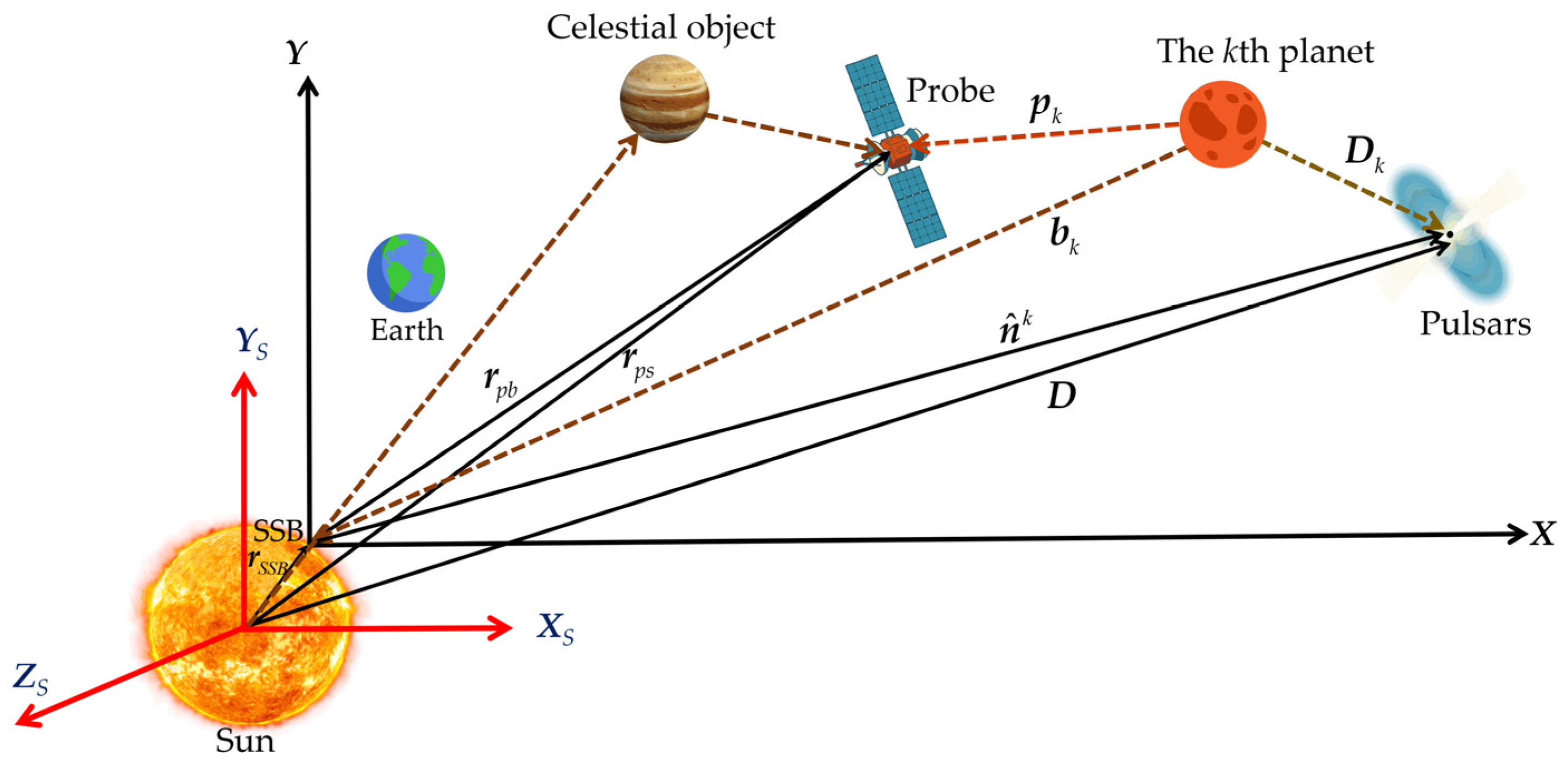
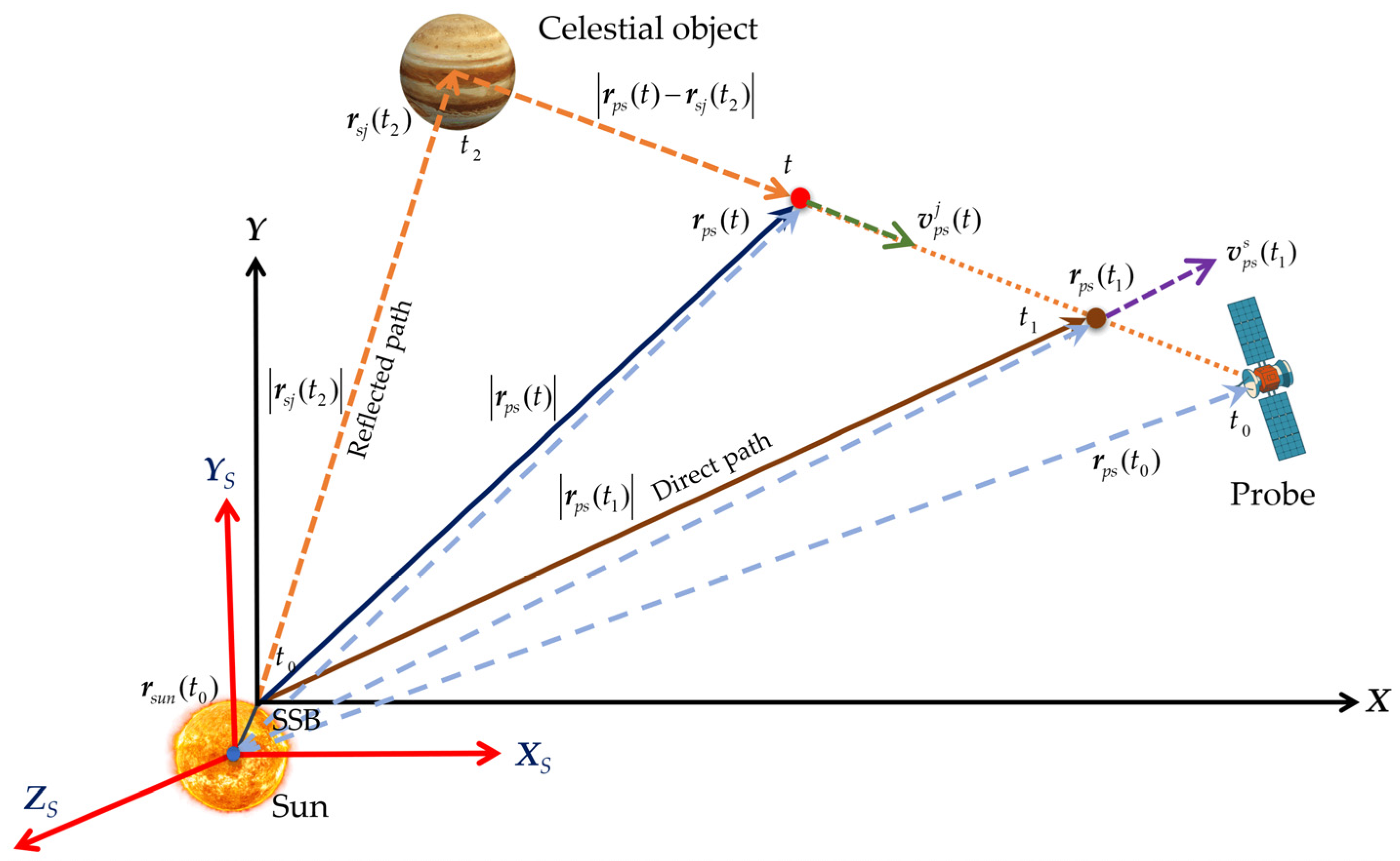
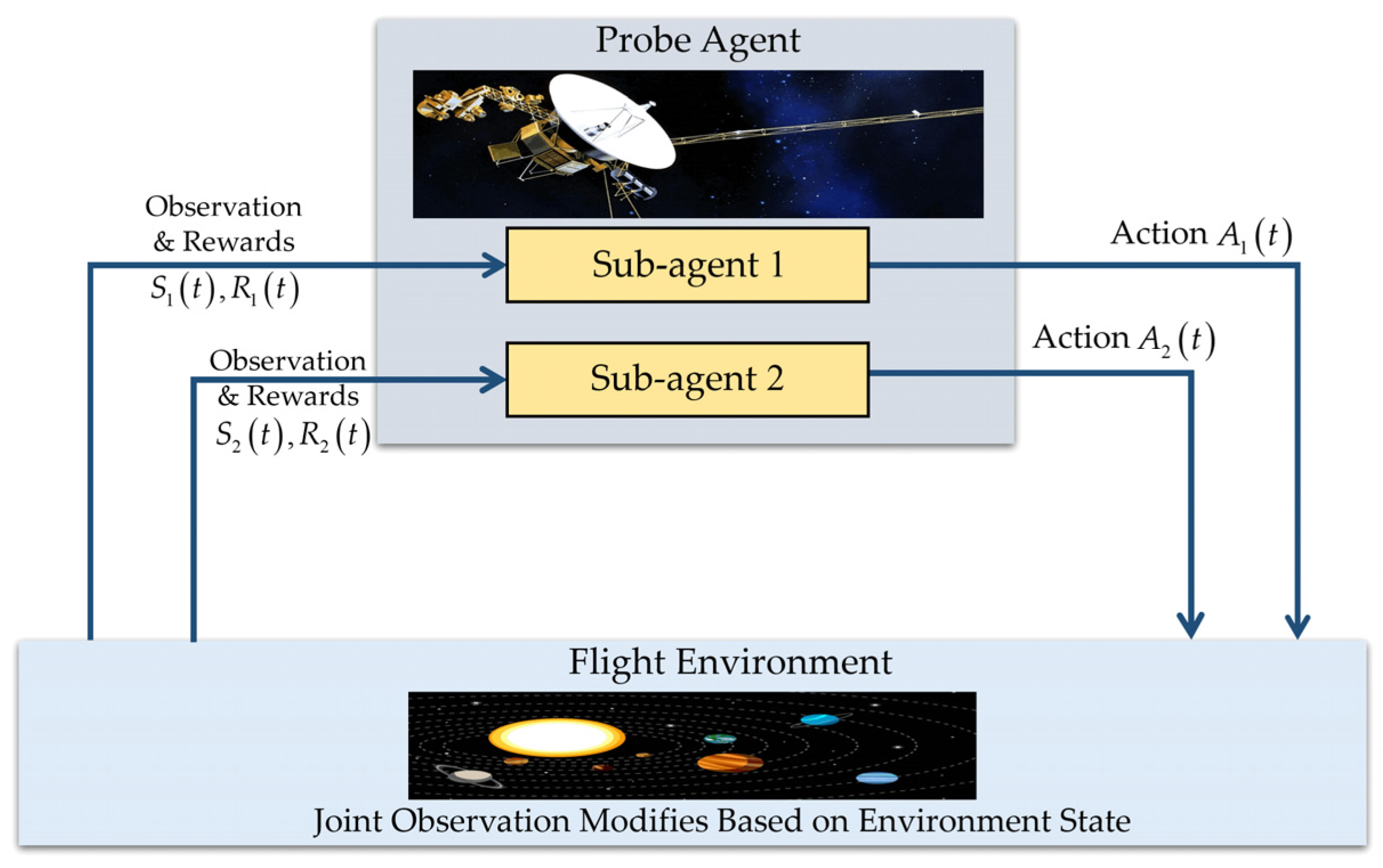

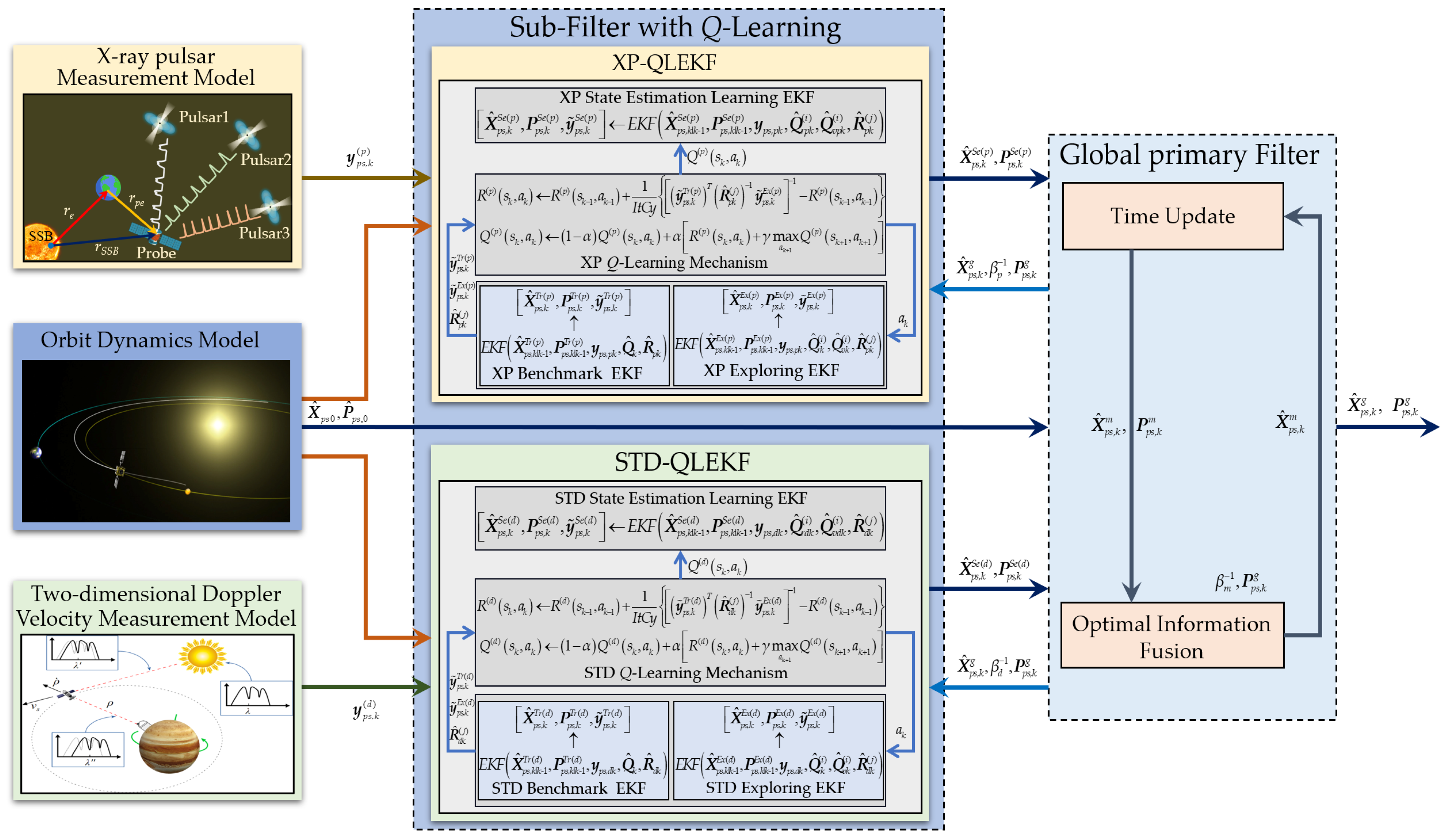
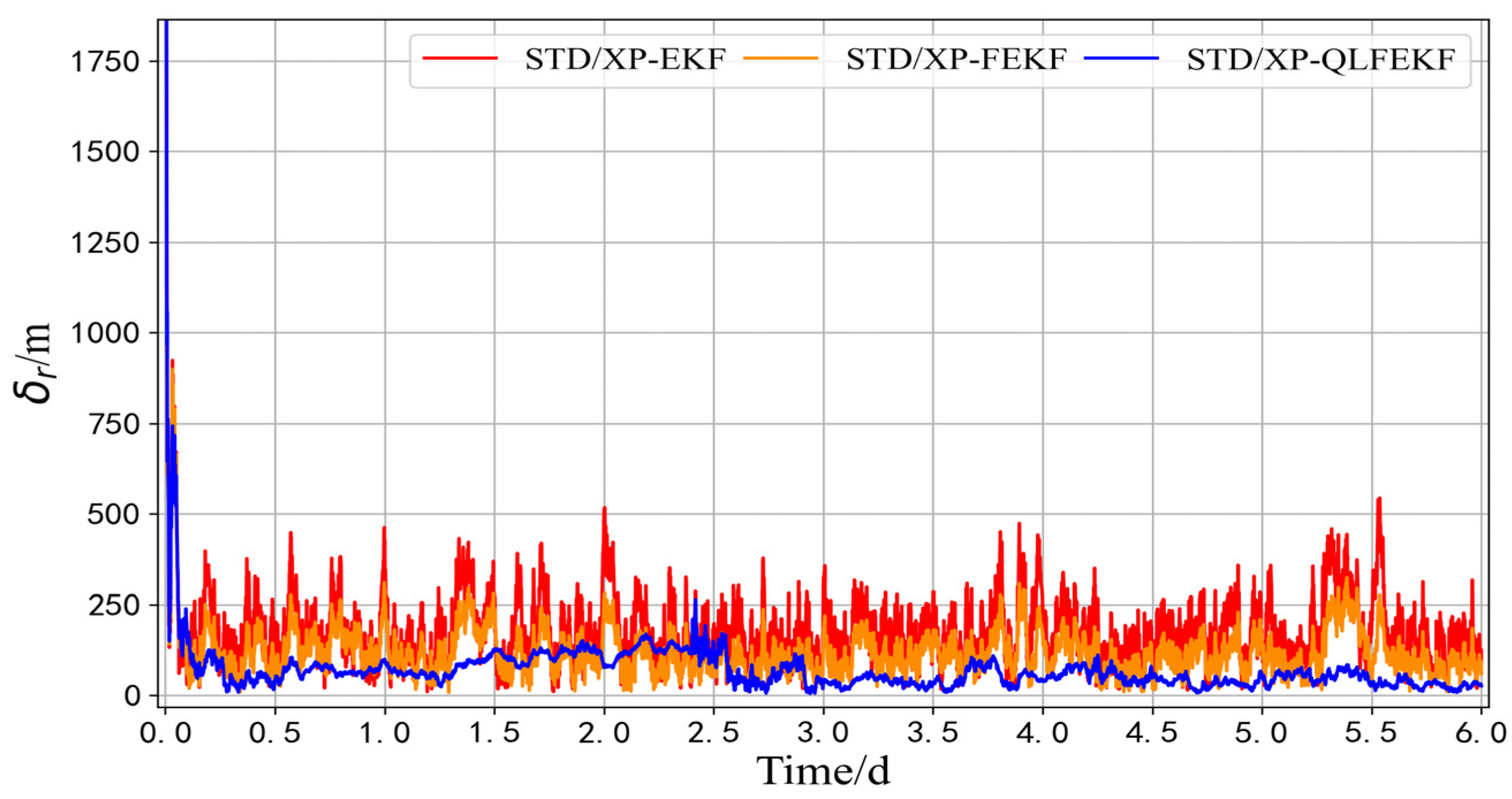
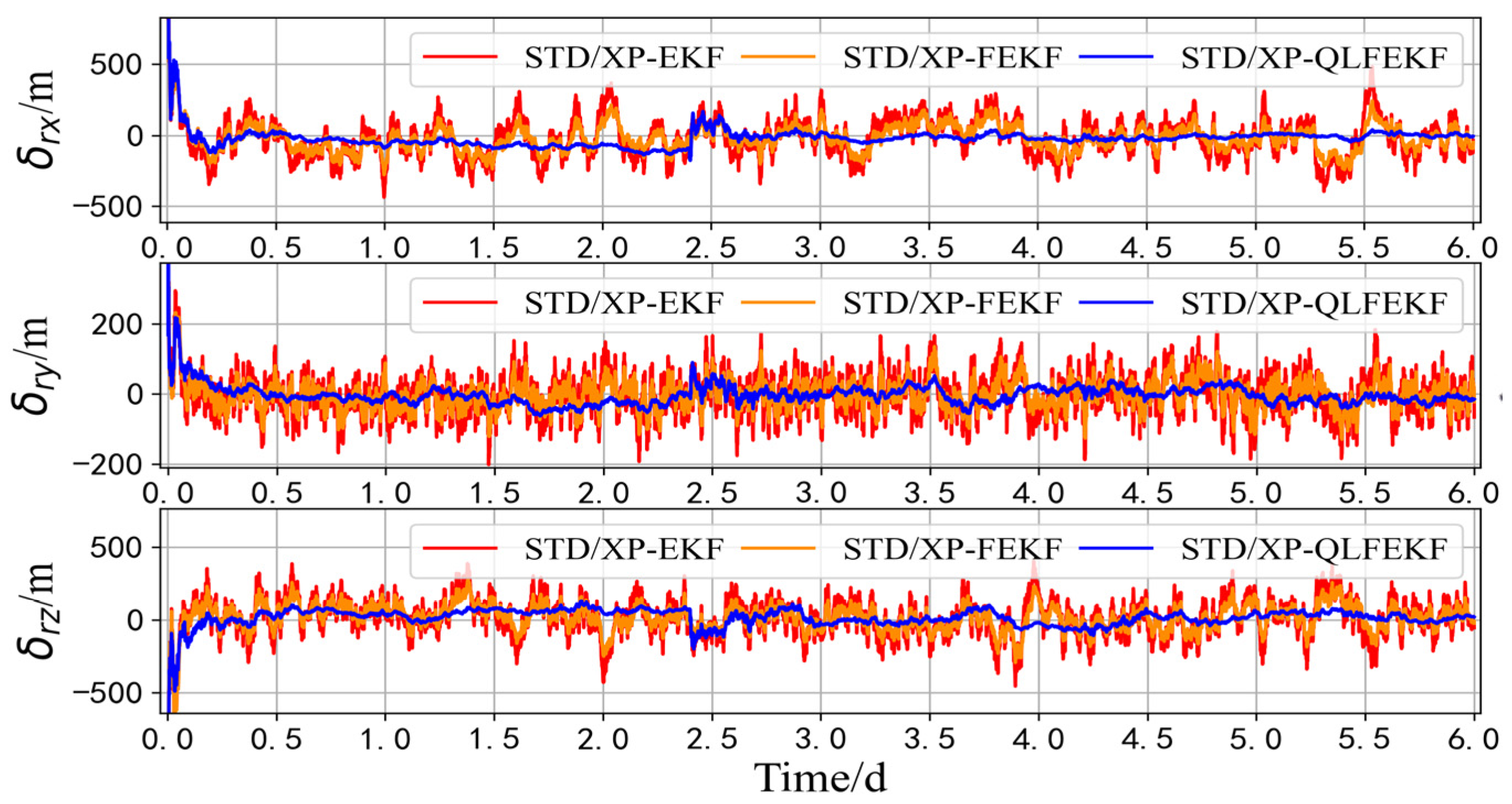
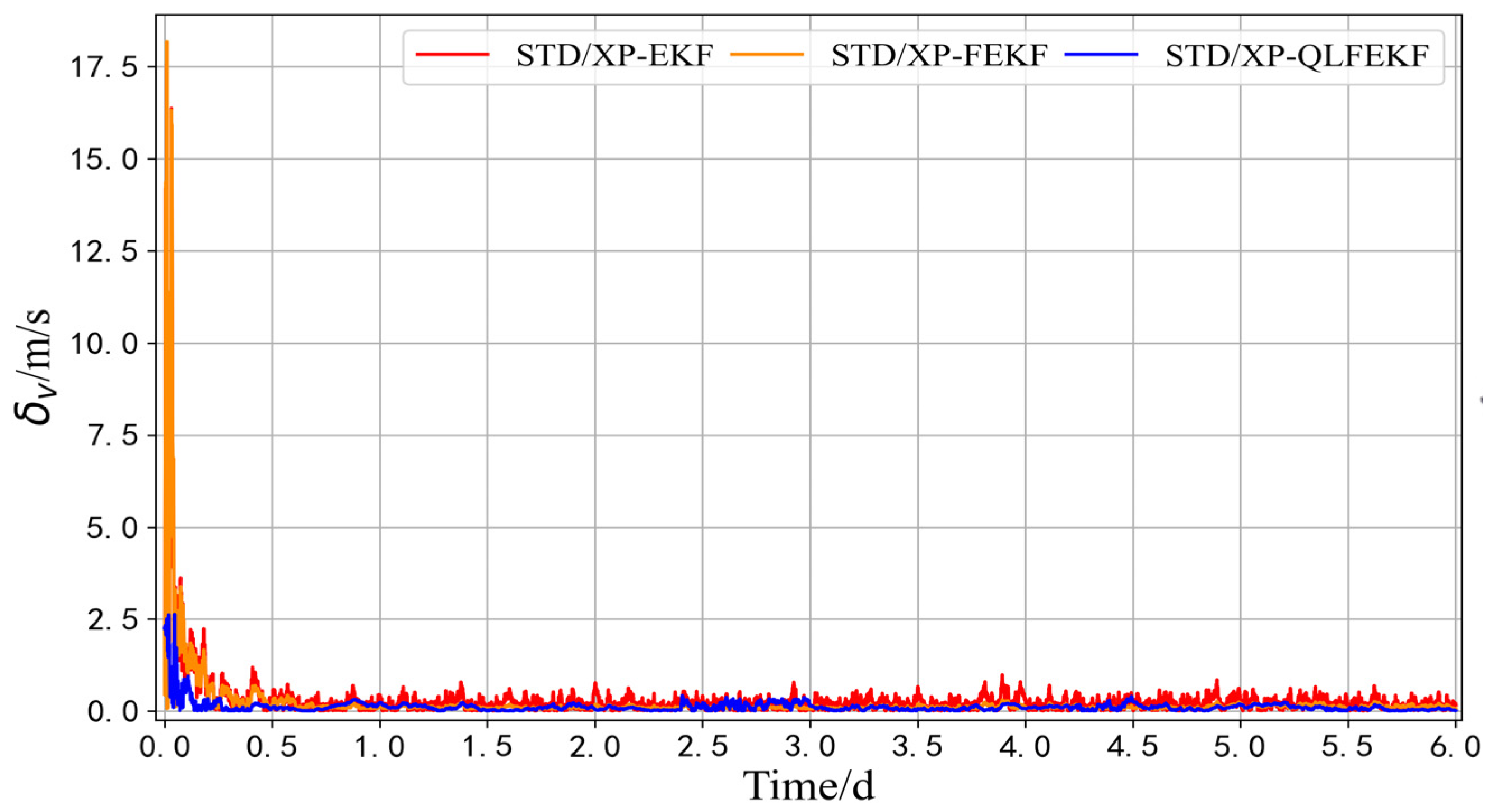
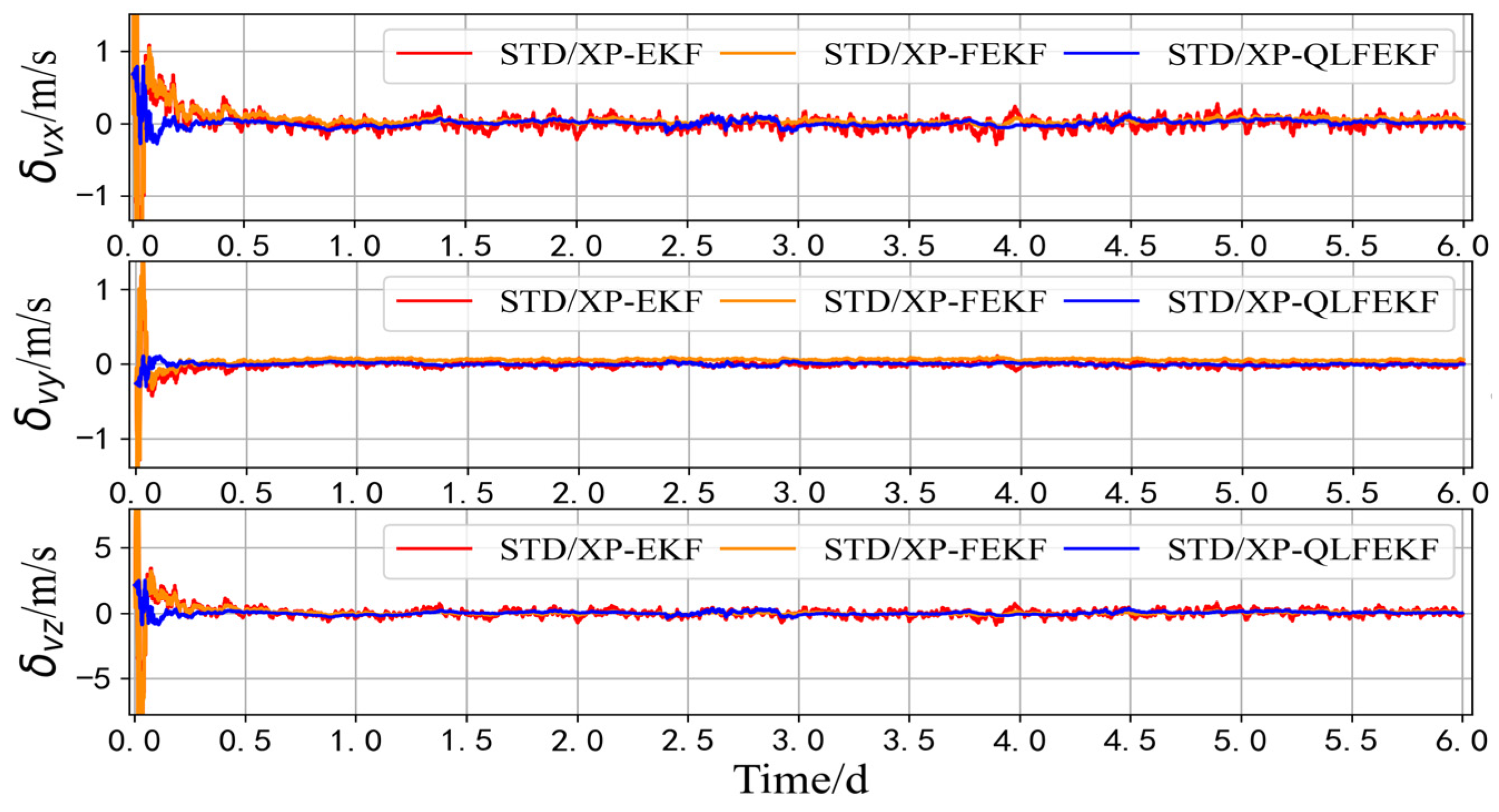
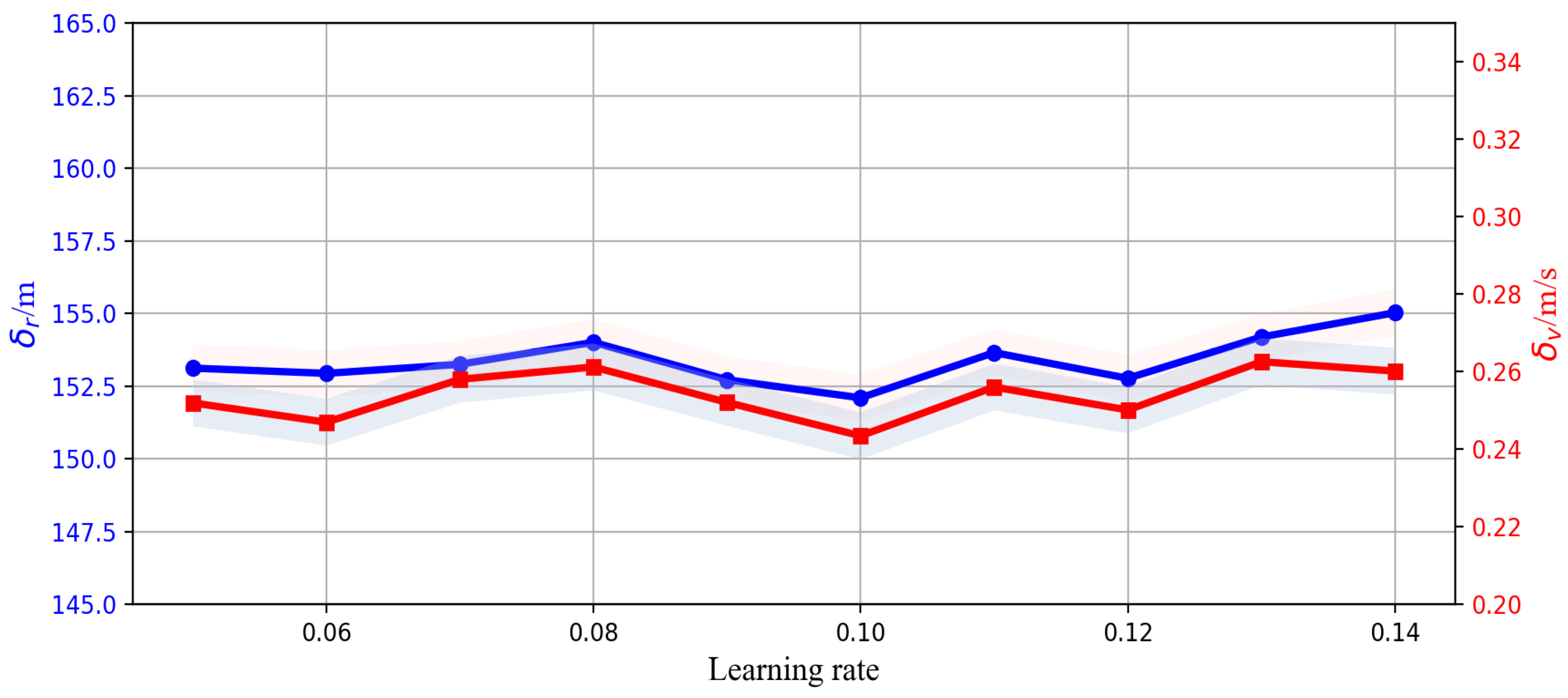
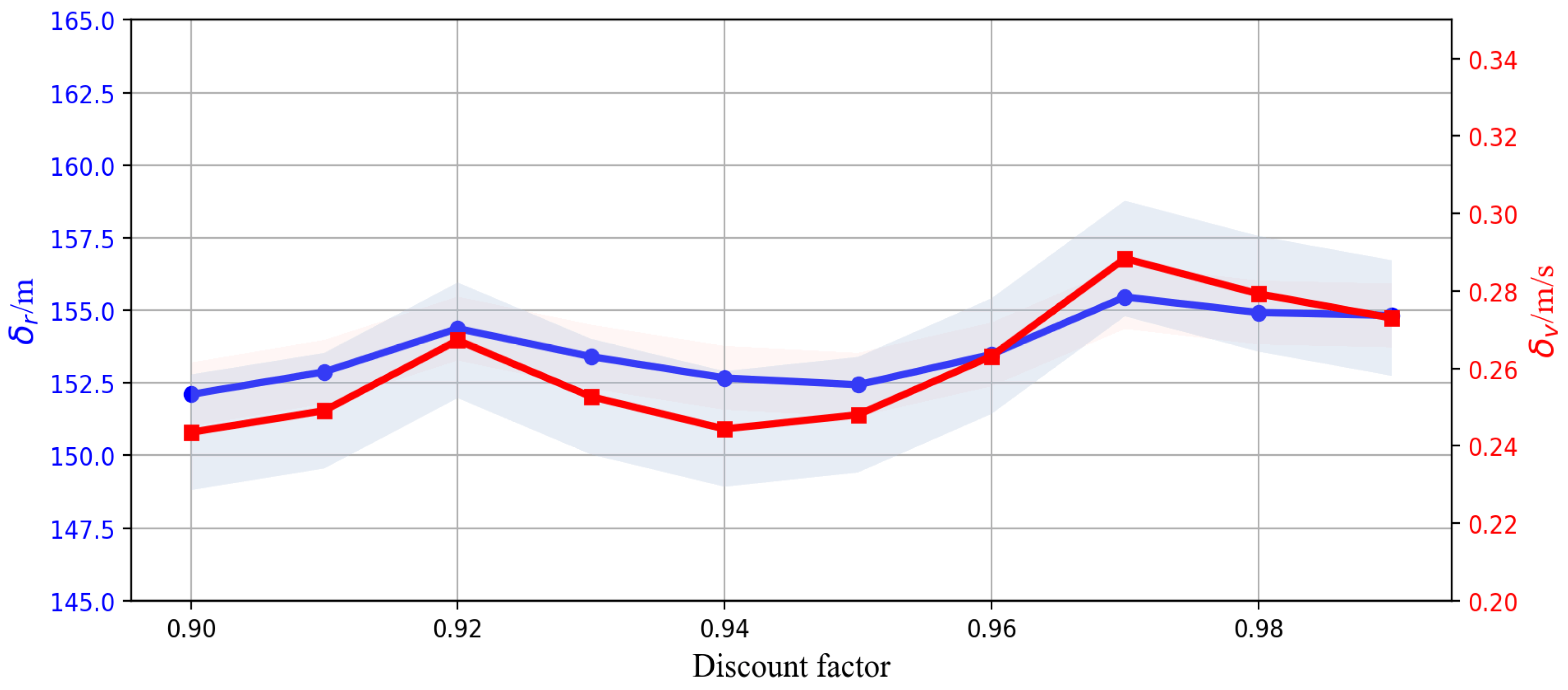
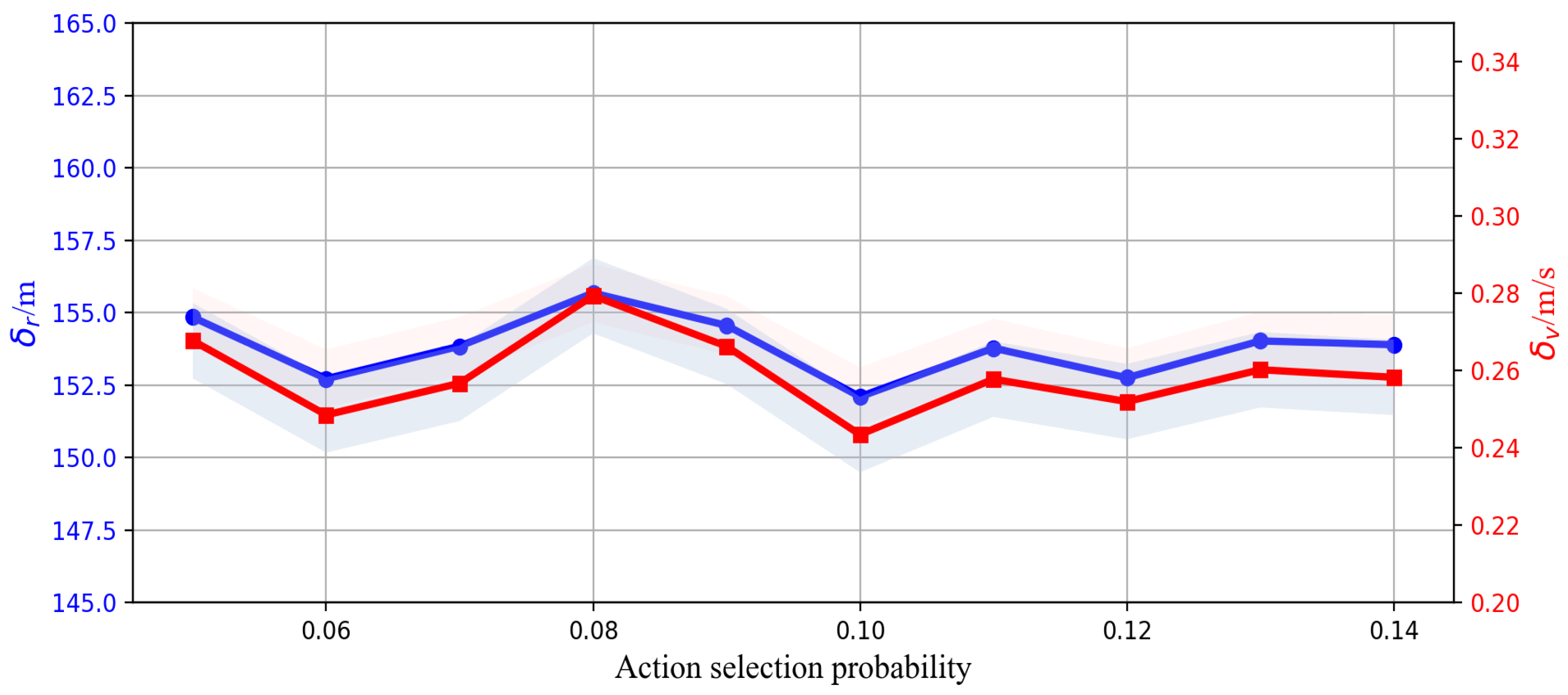
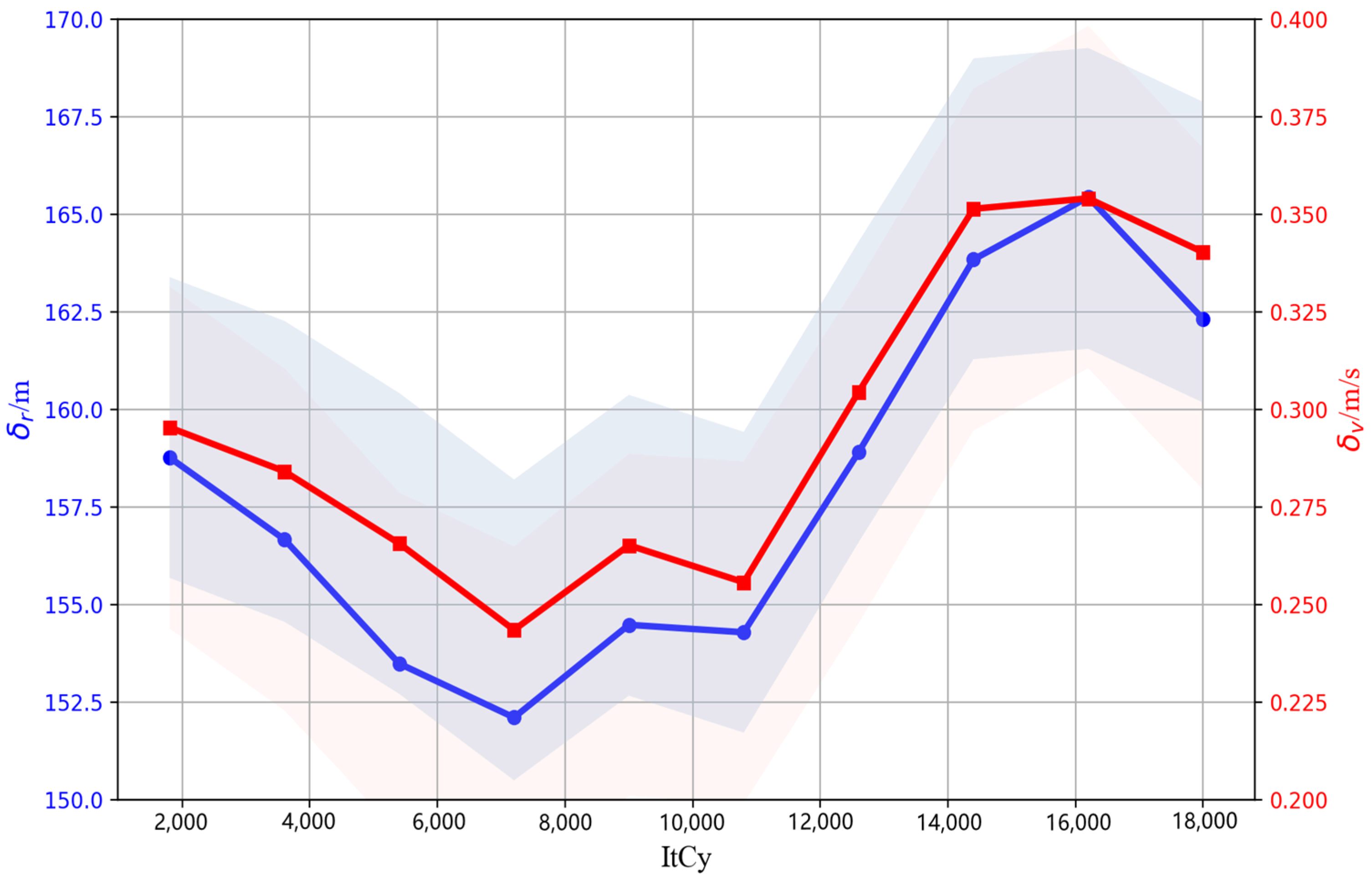
| Simulation Conditions | Parameters Value |
| Initial position values | [53,107,871.00559; 137,626,318.36608; −10,143.24541] km |
| Initial velocity values | [−14.01219; 35.86413; 0.42128] km/s |
| Initial state errors | δX0 = [δrx, δry, δrz, δvx, δvy, δvz]T δrx = δry = δrz = 1.0 × 102 km, δvx = δvy = δvz = 2.0 × 10−3 km/s |
| Initial state estimation covariance | |
| Initial state process noise covariance | , q1 = 2.0 × 10−3 km; q2 = 3.0 × 10−6 km/s |
| Pulsars Name | RAD (°) | DEC (°) | D0 (kpc) | P (10−3 s) | W (10−3 s) | Fx (ph/cm2/s) | Pf (%) |
|---|---|---|---|---|---|---|---|
| PSR B1937+21 | 294.92 | 21.580 | 3.6 | 1.56 | 0.021 | 4.99 × 10−5 | 86 |
| PSR B0531+21 | 83.63 | 22.014 | 2.0 | 33.5 | 1.670 | 1.54 | 70 |
| PSR J1821-24 | 276.13 | −24.870 | 5.5 | 3.05 | 0.055 | 1.93 × 10−4 | 98 |
| Initial Condition | Parameters Name | Parameters Value |
|---|---|---|
| XNAV Measurement | Number of detectors | 3 |
| Effective area of the detectors | 1 m2 | |
| Measurement noise variance matrix | ||
| Solar/target planetary Doppler measurement | Number of the spectrometers | 2 |
| Accuracy of the spectrometers | d1 = d2 = 10−6 km/s | |
| Velocity measurement navigation measurement noise variance matrix |
| Parameter Name | Value | |
|---|---|---|
| Learning rate, discount factor, and greedy values | α | 0.1 |
| γ | 0.9 | |
| ε | 0.1 | |
| The upper edge and lower edge bounds of , , , and | [1/202 1/102] | |
| [1/102 102] | ||
| [1/102 1] | ||
| [1/102 1/101] | ||
| Filter Algorithm | Position Estimation Accuracy (m) | Velocity Estimation Accuracy (m/s) | ||||||
|---|---|---|---|---|---|---|---|---|
| rx | ry | rz | r | vx | vy | vz | v | |
| STD/XP-EKF | 414.797 | 174.586 | 380.772 | 443.560 | 0.196 | 0.089 | 0.610 | 0.630 |
| STD/XP-FEKF | 335.289 | 132.138 | 279.342 | 351.803 | 0.169 | 0.158 | 0.289 | 0.386 |
| STD/XP-QLFEKF | 148.075 | 65.095 | 78.936 | 152.101 | 0.086 | 0.104 | 0.150 | 0.243 |
| Navigation accuracy improvement rate | 55.84% | 50.73% | 71.74% | 56.76% | 49.11% | 34.18% | 48.10% | 37.04% |
Disclaimer/Publisher’s Note: The statements, opinions and data contained in all publications are solely those of the individual author(s) and contributor(s) and not of MDPI and/or the editor(s). MDPI and/or the editor(s) disclaim responsibility for any injury to people or property resulting from any ideas, methods, instructions or products referred to in the content. |
© 2024 by the authors. Licensee MDPI, Basel, Switzerland. This article is an open access article distributed under the terms and conditions of the Creative Commons Attribution (CC BY) license (https://creativecommons.org/licenses/by/4.0/).
Share and Cite
Tao, W.; Zhang, J.; Song, J.; Lin, Q.; Chen, Z.; Wang, H.; Yang, J.; Wang, J. Intelligent QLFEKF Integrated Navigation for the SSBE Cruise Phase Based on X-Ray Pulsar/Solar and Target Planetary Doppler Information Fusion. Remote Sens. 2024, 16, 4465. https://doi.org/10.3390/rs16234465
Tao W, Zhang J, Song J, Lin Q, Chen Z, Wang H, Yang J, Wang J. Intelligent QLFEKF Integrated Navigation for the SSBE Cruise Phase Based on X-Ray Pulsar/Solar and Target Planetary Doppler Information Fusion. Remote Sensing. 2024; 16(23):4465. https://doi.org/10.3390/rs16234465
Chicago/Turabian StyleTao, Wenjian, Jinxiu Zhang, Jianing Song, Qin Lin, Zebin Chen, Hui Wang, Jikun Yang, and Jihe Wang. 2024. "Intelligent QLFEKF Integrated Navigation for the SSBE Cruise Phase Based on X-Ray Pulsar/Solar and Target Planetary Doppler Information Fusion" Remote Sensing 16, no. 23: 4465. https://doi.org/10.3390/rs16234465
APA StyleTao, W., Zhang, J., Song, J., Lin, Q., Chen, Z., Wang, H., Yang, J., & Wang, J. (2024). Intelligent QLFEKF Integrated Navigation for the SSBE Cruise Phase Based on X-Ray Pulsar/Solar and Target Planetary Doppler Information Fusion. Remote Sensing, 16(23), 4465. https://doi.org/10.3390/rs16234465







